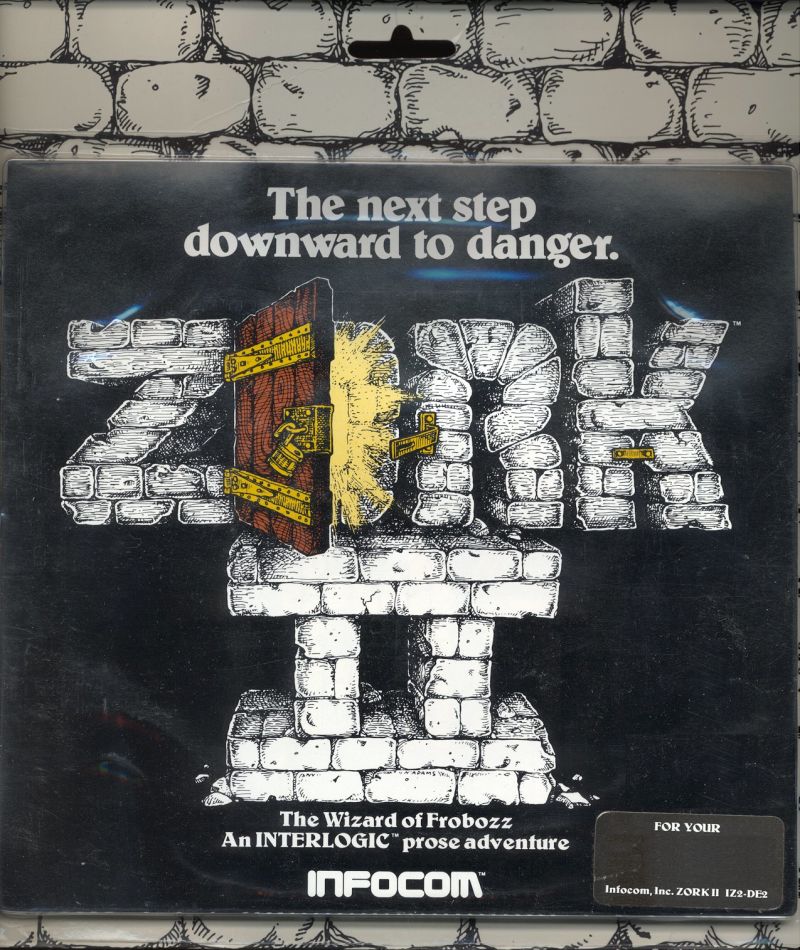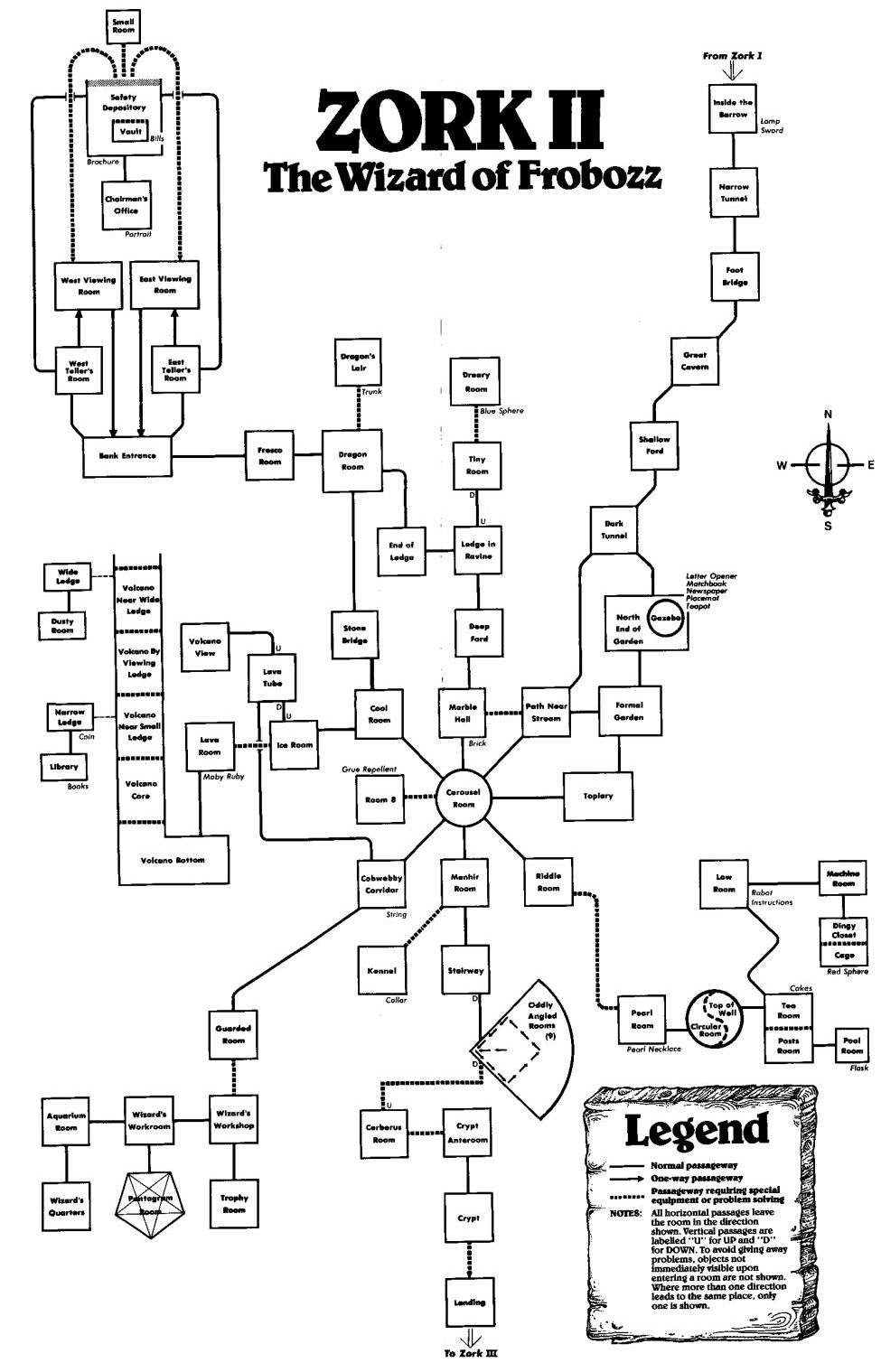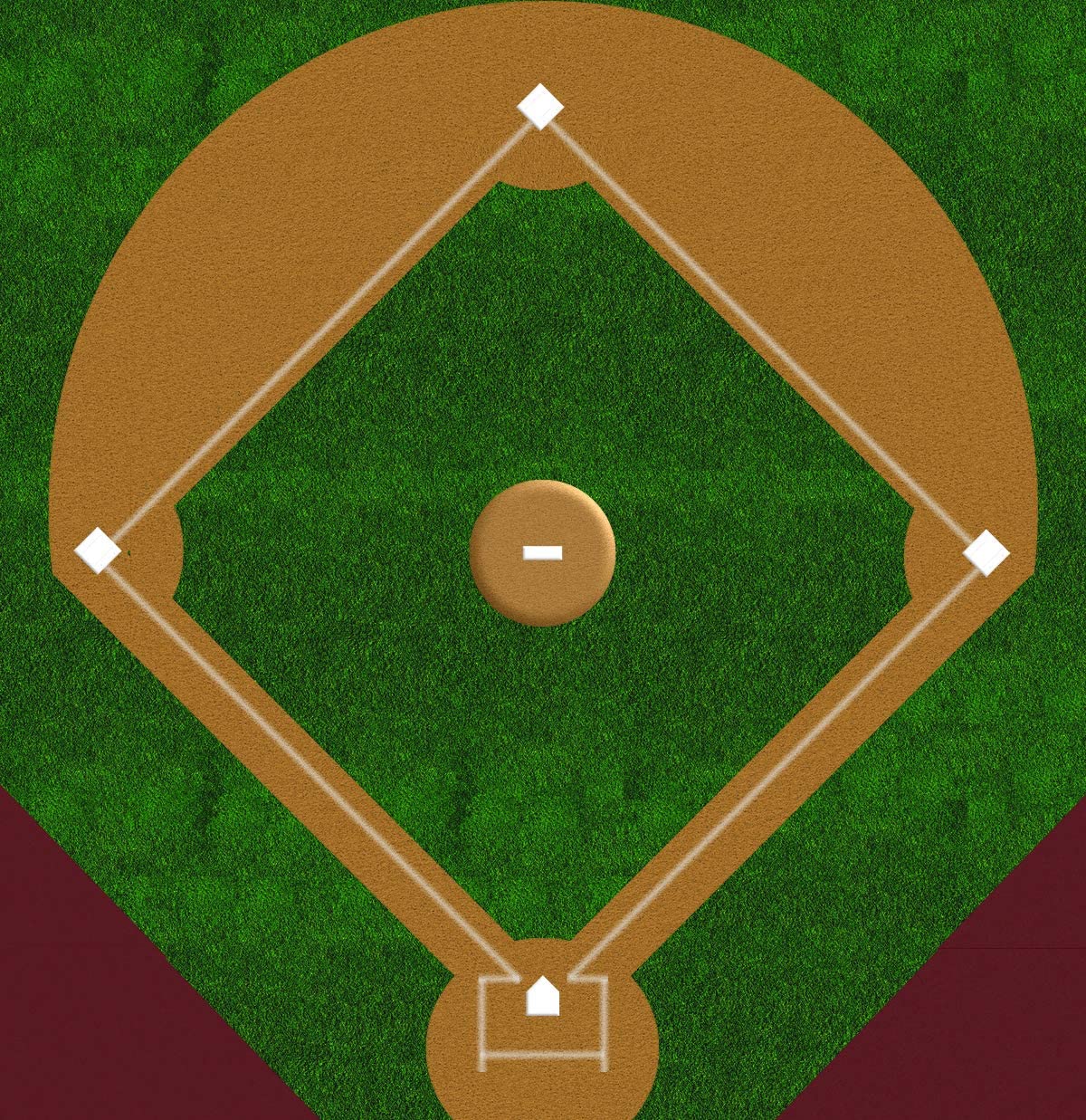IFDB page: Enchanter
[This review contains lots of major spoilers for Enchanter, plus spoilers of various sizes for lots of Zork games. Also, I wrote an introduction to these Infocom >RESTART reviews, for those who want some context.]
Having finished all the Infocom games with the word “Zork” in their names, Dante and I turned our attention to the game we glimpsed when Zork III‘s Scenic Vista let us see the future, the game that would have been called Zork IV but instead became Enchanter. Infocom made a great call by keeping the Zork brand off this game, because its primary mechanic fundamentally separates it from the original trilogy.
That basic mechanic — spellcasting — is dynamite. Instead of accumulating more and more objects, the PC of this game accumulates skills, sometimes even superpowers. Sure, some of these skills are comically puzzle-specific, but even so, every new spell added to the spell book makes the PC feel more capable and powerful. Rather than just some wandering kleptomaniac who knows how to put rod A into slot B and goes around doing various versions of that again and again, the Enchanter protagonist feels like an organically growing and improving being.
That sense of growth and improvement works well in tandem with the plot, too. That’s right: plot. There’s more story in Enchanter than in all the original trilogy games put together. Yes, wisps of story had started to appear with the Wizard of Frobozz and the Dungeon Master, but this game gives us a full-fledged quest plot with dramatic stakes, not just a shambolic treasure hunt.
As plots go, it’s fairly rudimentary and rather logically flawed — we’re really placing the fate of the realm in the hands of someone with almost no skills? Okay, I guess there’s a prophecy or something, but it’s all a little pat and strains credulity. (Comp99’s Spodgeville Murphy ably parodies this notion with its line, “Another champion must be sought; an idiot unskilled in anything but adventuring…”) Still, compared to the Zork trilogy, a plot framework like this is a quantum leap forward. And having established that the PC starts with very few skills makes the skill-building experience that much more exciting and rewarding.
>EXAMINE ADVENTURER
So Enchanter distinguishes itself from Zork both by its level of character specificity and its level of narrative drive, and it’s clearly well aware of the comparison, because it plays up the contrast to hilarious effect via its inclusion of the adventurer NPC. He’s the source of most of the game’s best jokes, and we were exactly the right audience for them, having just played through five Zork games. Some of our favorite lines:
- The adventurer stares at his possessions as if expecting a revelation.
- The adventurer pulls out his map, a convoluted collection of lines, arrows, and boxes, and checks it briefly.
- The adventurer asks for directions to Flood Control Dam #3.
- The adventurer waves at you and asks “Hello, Sailor?” Strange, you’ve never even been to sea. [Even better, if you respond to this by giving him something, say your loaf of bread:] A wide smile comes over his face as he takes the loaf of bread, as though your action resolved for him some great mystery.
- The adventurer offers to relieve you of some of your possessions.
- [If the enchanter follows you onto the illusory stairs, which support you but not him:] The adventurer seems to have dropped out of existence. In a voice that seems to recede into the void, you hear his final word: “Restore….” You muse about how a mere adventurer might come to possess a spell of such power.
- The adventurer attempts to eat his sword. I don’t think it would agree with him.
So this is clearly the Zork adventurer, and even the way you acquire him — from the other side of a magical mirror — has a wonderful resonance with the teleportation mirrors of Zork I. But in case you thought perhaps he’d warped in from another universe or something, the details of the Gallery location dispel that idea immediately:
Gallery
The east-west corridor opens into a gallery. The walls are lined with portraits, some of apparently great value. All of the eyes seem to follow you as you pass, and the entire room is subtly disturbing.
>examine portraits
The portraits represent a wide cross-section of races. Elves, gnomes, dwarves, wizards, warlocks, and just plain folk are all here. Some of them are known to you, such as Lord Dimwit Flathead of the Great Underground Empire, depicted here in excessive detail, and the Wizard of Frobozz, shown in a typical pose of anguished bewilderment.
The adventurer himself has a satisfying reaction if you happen to catch him wandering into this location:
The adventurer stops and stares at the portraits. “I’ve met him!” he gasps, pointing at the Wizard of Frobozz. He doesn’t appear eager to meet him again, though. “And there’s old Flathead! What a sight!” He glances at the other portraits briefly and then re-checks his map.

So while the contrast between the enchanter and the adventurer makes it clear that Enchanter isn’t Zork IV (despite what the Scenic Vista suggests), it is an extension of the Zork universe. Dante and I, having skipped around in time a bit, had already seen the union of spellcasting-Zork and treasure-hunting-Zork in the later games, and in fact some of our discoveries here helped explain throwaway references in those games, such as Beyond Zork‘s casual mention that “Aggressive ad campaigns and the deregulation of ZIFMIA spells have made Miznia’s Jungle Skyway the fifth biggest tourist attraction in the Southlands.” In Enchanter, Zifmia can only summon beings of great magical power or beings you can see, but apparently later the rules loosen up enough that it can be used for casual travel. The idea that spell restrictions are largely the product of bureaucratic regulations is a funny one, considering that they’re really the product of technical limitations and the necessity to constrain combinatorial explosions in game design.
>GRIPE ABOUT TIMERS
If only Infocom had done a little deregulation of their other limits. For whatever reason, designers Marc Blank and Dave Lebling decided to impose three different timers in this game: one for hunger, one for thirst, and one for sleep. That’s on top of the never-stops-being-annoying inventory limit, which felt particularly draconian here. Infocom’s previous game, Planetfall, also inflicted these three timers on players, so I guess Enchanter just had the misfortune to fall into the period of IF evolution between, “Hey, these timers make the game more realistic!” and “Hey, these timers make the game a lot less fun.”
The thirst timer isn’t terrible — there’s an endless source of water available, though occasionally you may have to trundle over to it. Still, it’s mostly just an annoyance. Food, on the other hand, has a hard limit — there’s a loaf of bread that lasts something like 7 meals, and when it’s gone, it’s gone. Enchanter continued Infocom’s streak of making us replay games, and that hunger timer was a big part of how it did so. (The other part was finding out we’d locked ourselves out of victory in our first few moves — more about that in a moment.)
Then there’s the sleep timer. While not as unforgiving as the hunger timer, it did introduce a whole new way to suddenly lose — you can get robbed while you sleep! Apparently this is the best use for the Blorb spell, but you have to learn that the hard way. Incidentally, Dante and I played a bit of Enchanter together when he was much younger, and this bedtime theft (combined with me saying, “We’ve been robbed!”) upset him so much that he dropped the game completely.
On the other hand, Enchanter does a few things with its sleep timer that make it almost worth having. For one, there’s a puzzle that flat-out requires sleep. Fall asleep on a beautiful bed, get rewarded with the location of a new scroll you’d never have found otherwise. That’s easy enough. Even more enticing, though, are the hints you get while dreaming. These dreams make perfect sense with the character, a novice spellcaster with the potential for greater power, and a connection to the mystical forces of the universe. Plus, they can help get you unstuck — always appreciated. One of those dreams brilliantly hinted us toward the solution to a puzzle:
After a while, your sleep is disturbed by a strange dream. You are wandering in a darkened place, for you have no light or other possessions. You feel that you are being watched! You are surrounded by faces, their eyes following you. They drift in and out, staring at you with proud indifference. One face, brightly lit (unlike the rest), draws you closer and closer. As you touch it, you wake.
It took a few repetitions of this before we caught on — and the game gets increasingly insistent about signaling that this is a hint — but finally we understood that it referred to the Gallery, and further understood what we had to do, given that a nearly identical puzzle appears at the end of Zork II. Unfortunately, that was also when we realized that we’d locked ourselves out of victory.
See, one of the most satisfying parts of Enchanter is the way it obviates some of the recurring frustrations of earlier Zork games. For a player who has struggled with one lock after another, possessing a Rezrov spell feels marvelously empowering. Never again, locks! (Not true, but it still feels great when Rezrov pops something open.) Similarly, the Frotz spell meant that our days of struggling against light limits were over at last! “Frotz me” was one of the first commands we typed once we understood that the PC could finally be its own light source. Which is great… except when you need darkness. It wouldn’t be until Spellbreaker that Infocom would allow the “Extinguish” verb to undo a “Frotz me”, so… RESTART!

Unfortunately, there was no spell that improved our carrying capacity, which meant that we were frequently told that we were carrying too many things already. Usually an annoyance, this behavior became downright infuriating with a grabby fellow like the adventurer around — when we opened up a new location, he would charge right in and take everything we hadn’t been able to pick up, which tended to be most things, given the game’s insistence on inventory limits. One silver lining: there was a lot of comedy value to be had from checking out the adventurer’s inventory, which besides his own sword and lamp was generally made up of our castoffs:
There is a bedraggled and weary adventurer standing here. He is carrying a sacrificial dagger, a lighted portrait, a dusty book, a purple scroll, a sword, and a brass lantern.
He’s like a sillier version of the Zork I thief, or maybe a deranged magpie who doesn’t restrict himself to just the shiny objects.
The adventurer focuses entirely on objects, while the enchanter cares much more about scrolls, whose physical presence is ephemeral, but whose contents can be used over and over. Put another way, the adventurer’s power comes from having things, while the enchanter’s power comes from knowing things. For kids whose knowledge greatly outstrips their wealth, this is a pretty appealing formulation.
The mind-body split between these two characters also figures into the game’s puzzles, in which the adventurer can ignore mental barriers such as illusions, breaking through with a basic physicality that can pave the way for the enchanter. On the flip side, the enchanter can use a spell (not an object) to change the adventurer’s mood, so that he’s willing to cooperate. I would totally play a game (or for that matter, watch a TV show or movie) in which these two team up for a whole story to solve problems.
>ANALYZE PUZZLES
The puzzles in Enchanter overall are quite clever and fun on average. We particularly enjoyed the Unseen Terror puzzle, with its ASCII art and its multi-step luring and trapping mechanic. Figuring out the right combination of spells and objects to get the sacrificial dagger was another favorite. Oh, and the rainbow turtle! That one was a little awkward with its syntax, but once we understood how to tell the game our idea, it was quite a thrill seeing it work.
The final puzzle, however, stymied us for quite some time, and here is where Enchanter‘s spell-specific puzzle gimmick shows its weakness. See, when there’s one spell and only one spell that can resolve a situation, you’re at an impasse unless you’ve found that spell, but you likely don’t even know you’re at that impasse. Now, one could argue this is really no different than a Zork game, in which there is often one and only one object that can unlock a puzzle, but I think there’s a qualitative difference.
Because objects are concrete items that tend to have very specific or limited capabilities, it’s more clear when you’re missing one. Say you find a bolt that needs turning — it’s pretty certain that a sword or a hot pepper sandwich is not going to do the job. You clearly need a wrench. Now say you find a fire-breathing dragon. Could you make it your friend, or change it into a newt, or talk to it? Well, why not? Those all seem like reasonable solutions to the problem, and if they don’t work, it’s only because the game rather arbitrarily decides that they don’t. When it turns out that you must have a “quench an open flame” spell, you might justifiably cry foul, especially when a dragon is much more like a hostile creature than an open flame. By building the skills and powers of the PC, Enchanter comes closer and closer to risking logical breaks by deciding that those powers are only allowed to apply to some situations and not other, very similar situations.
The other weakness of this scenario is that the Gondar spell (the open-flame-quenching one) is only available from searching a second-level noun — that is, an object mentioned in the description of another object rather than the description of a room. Given how many first-level nouns go undescribed in Enchanter and all its predecessors, expecting that kind of search behavior seems a little beyond the pale. We needed a hint to get there.
Once we got that hint, and were sufficiently Gondared, the climactic sequence of the game became finishable, and we finished! Banishing Krill was as satisfying as we’d hoped, and we were excited to know that much more IF with this fun spellcasting mechanic awaited us!







